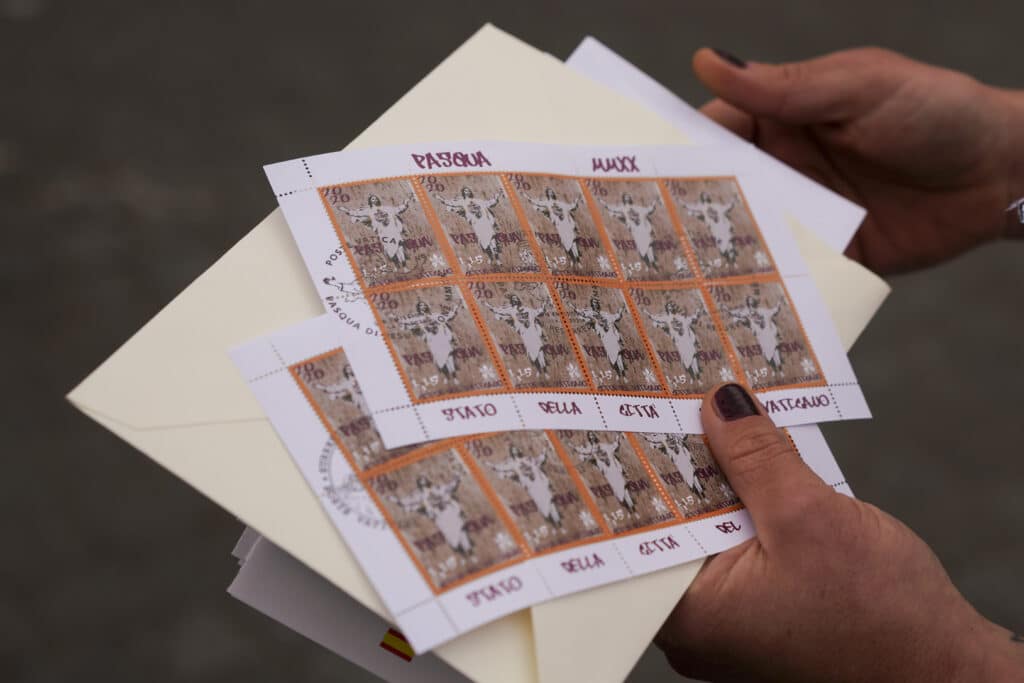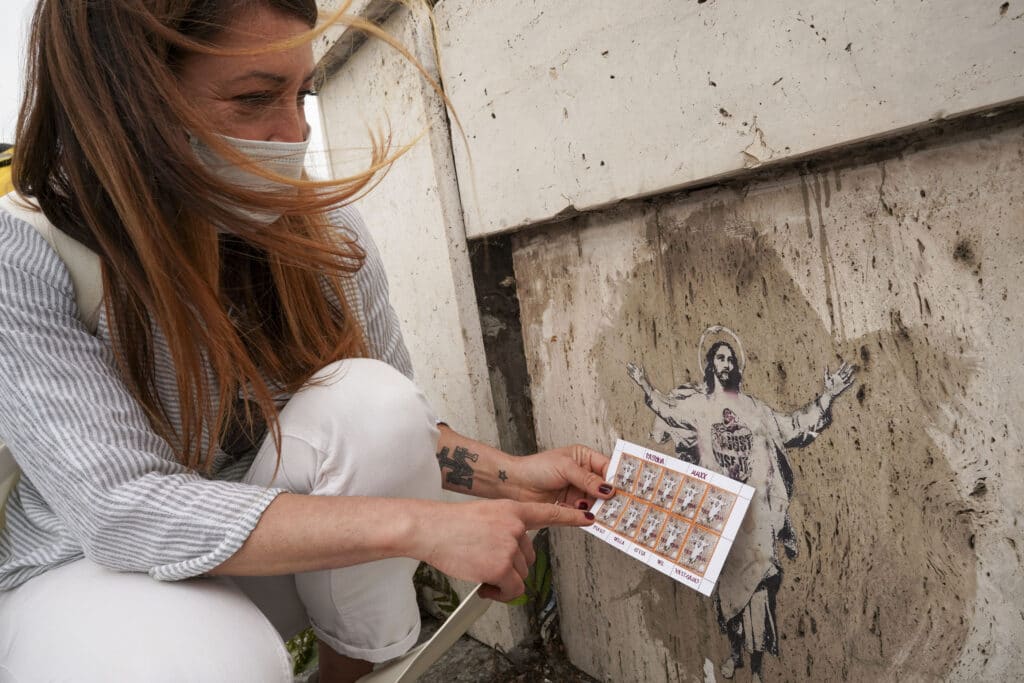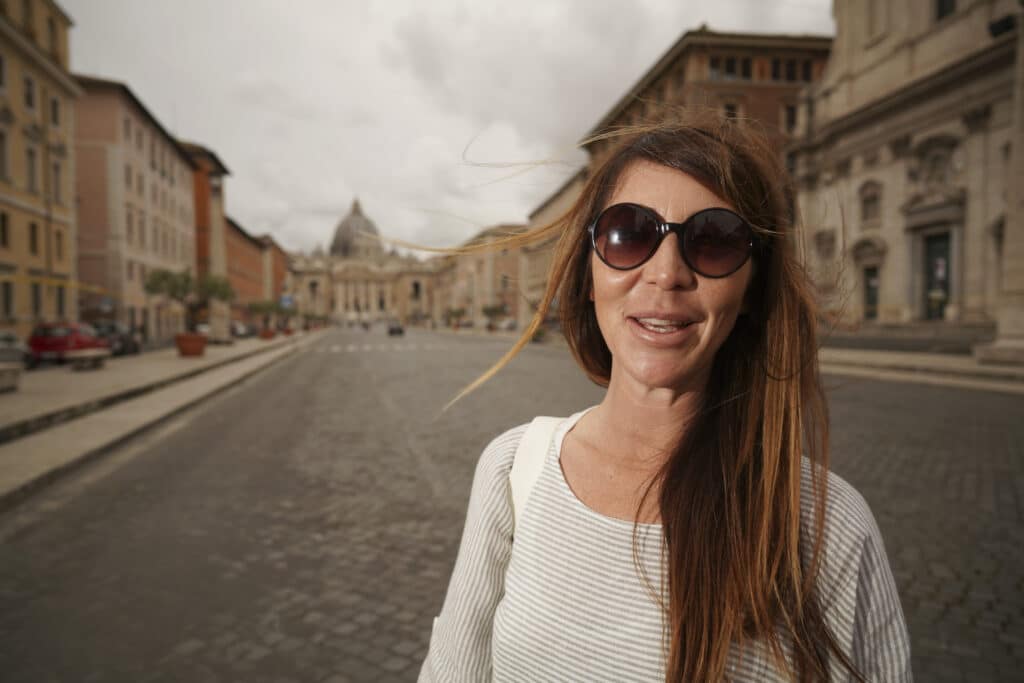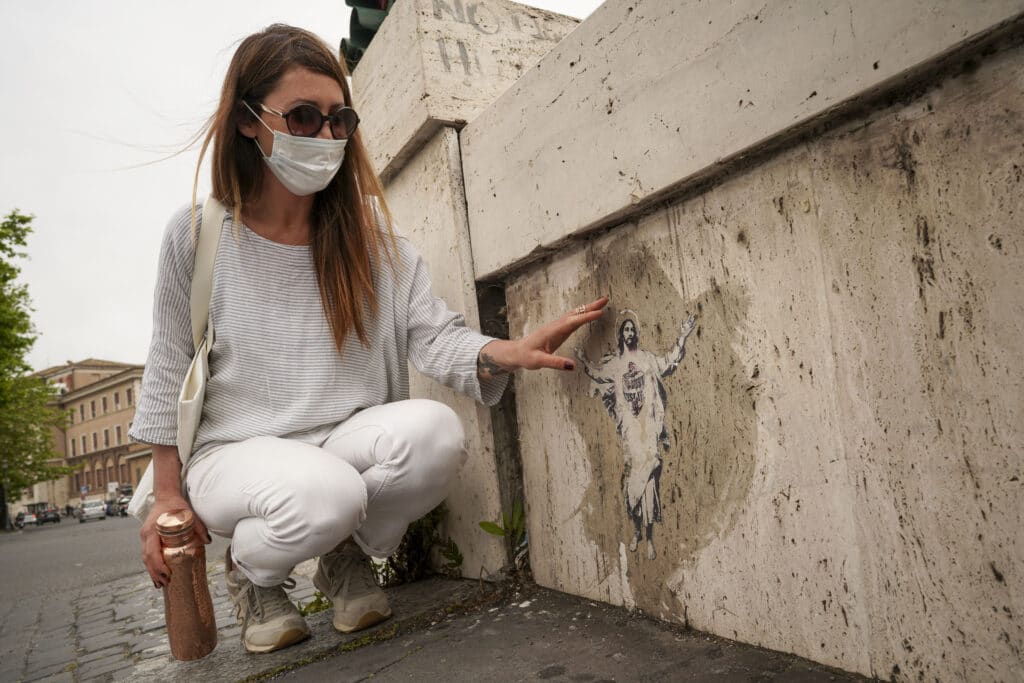Rome street artist Alessia Babrow is suing the Vatican over a 2020 Easter postage stamp it issued that she claims looks like her street art. The art features a heart over Christ’s chest. The Associated Press has the story:
Street artist sues the Vatican claiming it copied her Christ art without her permission
ROME (AP) — One night in early 2019, Rome street artist Alessia Babrow glued a stylized image of Christ she had made onto a bridge near the Vatican. A year later, she was shocked to learn that the Vatican had apparently used a reproduction of the image, which featured Babrow’s hallmark heart emblazoned across Christ’s chest, as its 2020 Easter postage stamp.
Babrow sued the Vatican city-state’s telecommunications office in a Rome court last month, alleging it was wrongfully profiting off her creativity and violating the intent of her artwork. The lawsuit, which is seeking nearly 130,000 euros ($160,000) in damages, said the Vatican never responded officially to Babrow’s attempts to negotiate a settlement after she discovered it had used her image without consent and sold it.

“I couldn’t believe it. I honestly thought it was a joke,” Babrow told The Associated Press in an interview, standing steps from St. Peter’s Square. “The real shock was that you don’t expect certain things from certain organizations.”
The Vatican is home to some of the greatest artworks ever made, and it vigorously enforces its copyright over everything from the Sistine Chapel to Michelangelo’s Pieta. But now the tables have turned, and the Vatican stands accused of violating the intellectual property rights of a street artist.
Related: LGBTQ Catholics Stung by Vatican Rebuff of Same-Sex Unions
The Vatican stamp office declined to comment on the lawsuit, said its chief, Massimo Olivieri. The Vatican press office also declined requests for comment.
Even anonymous graffiti or ‘guerrilla art’ deserves protection
Copyright lawyers familiar with the case say it is an important benchmark for Italy and evidence of the increasing appreciation for Banksy-style street art. They say it underscores that even anonymous graffiti or “guerrilla art” deserves protection against unauthorized corporate merchandising, or, in this case, church merchandising.
Massimo Sterpi, whose Rome firm has represented Banksy’s Pest Control agency in copyright cases, said intellectual property law in much of Europe and the United States protects artists’ rights even if a piece was created on public or private property illegally.
“The law considers it irrelevant if the work is made on paper, canvas or a wall or a bridge,” Sterpi said. People who commercialize street art without making good-faith efforts to find the artist and negotiate use of the image “do so at their own risk and peril,” he said.
Breaking: Pope Changes Catholic Church Law On Sexual Abuse
The artwork in question is a 35-centimeter-high (13.8-inch-high) printed picture of Christ styled on the famous work by the 19th-century German painter Heinrich Hofmann. On Christ’s torso is Babrow’s telltale tag: An image of a human heart with the words “JUST USE IT” written graffiti-style across.

The work is part of Babrow’s “Just Use It” project, which began in 2013 and has included similar hearts on Buddhas, the Hindu deity Ganesha and the Virgin Mary that can be found on walls, stairwells and bridges around Rome. A huge version also graces a palazzo scaffolding.
The concept of the project, Babrow says, is to “promote the intelligence and the brain of the heart” in a holistic, non-judgmental way. Lawyer Mauro Lanfranconi argued in the lawsuit that by appropriating the image to promote the Catholic Church, the Vatican “irrevocably distorted” Babrow’s message that there are no universal truths.
The Vatican printed 80,000 stamps with the art
The Vatican printed an initial 80,000 stamps of the Christ at 1.15 euros apiece, according to the lawsuit. The stamps and a commemorative folder were still on sale at the Vatican post office last week and were prominently featured at the cashier’s desk as a promotional item for sale.
Babrow says she created the Christ image on Feb. 19, 2019, and glued it soon thereafter onto a travertine marble wall just off the main bridge that leads to the Vatican, one of a dozen or so pieces of poster art she put up that night around central Rome. The work bears her scripted initials inside the heart.
She found out it had been used as the Vatican stamp when a well-known Rome street art photographer saw it and immediately recognized it as Babrow’s handiwork.
Olivieri, the Vatican’s numismatic chief, has told an Italian journalist that he took a photo of the Christ when he saw it while riding his moped one day and decided to use the image for the Easter stamp in an apparent attempt to appeal to a new generation of stamp enthusiasts.

In comments reported by the journalist in the online arts blog Artslife.com, Olivieri said he feared Holy See higher-ups might resist using a hip, graffiti-style stamp for Easter.
“Instead, the acceptance was immediate and convinced,” he was quoted as saying.
Babrow’s lawyers sent a registered letter and an email to the philatelic and numismatic office identifying Babrow as the artist, the lawsuit says, but there was no written response to her request to negotiate terms of use, prompting her to sue.
“I thought they were acting in good faith, that it was true they were looking for me, like had been written in the papers,” she said. “Only it seems it wasn’t that way because they never wanted to meet with me.”
Babrow stressed that the lawsuit wasn’t an attack on the Catholic Church or Vatican, but rather an attempt to protect her rights and make sure her artwork wasn’t being used to finance things outside her control.
Copyright lawyers said the Vatican’s status as a sovereign state likely wouldn’t protect it from an Italian court’s jurisdiction, given the commercial activity and alleged damage to Babrow occurred in Italy.
The case is somewhat surprising, given the Vatican is well-versed in intellectual property rights and has shown its eagerness to protect its own copyright over everything from the pope’s words to its vast art collections.
Years ago, the Vatican’s publishing house demanded royalties from journalists who wrote books reprinting Pope Benedict XVI’s homilies. The Vatican Museums has long required media covering news events in the museum to agree to turn over the copyright of their images, lest anyone try to reproduce a Raphael without the pope’s authorization.
Enrico Bonadio, professor of intellectual property law at the University of London’s City Law School, said street artists can use those same protections for their own creations.
“The law does not discriminate,” Bonadio said in a phone interview. “Copyright laws do not subject the protection of an artwork to the fact that it is in a gallery or a museum.”
By NICOLE WINFIELD |







